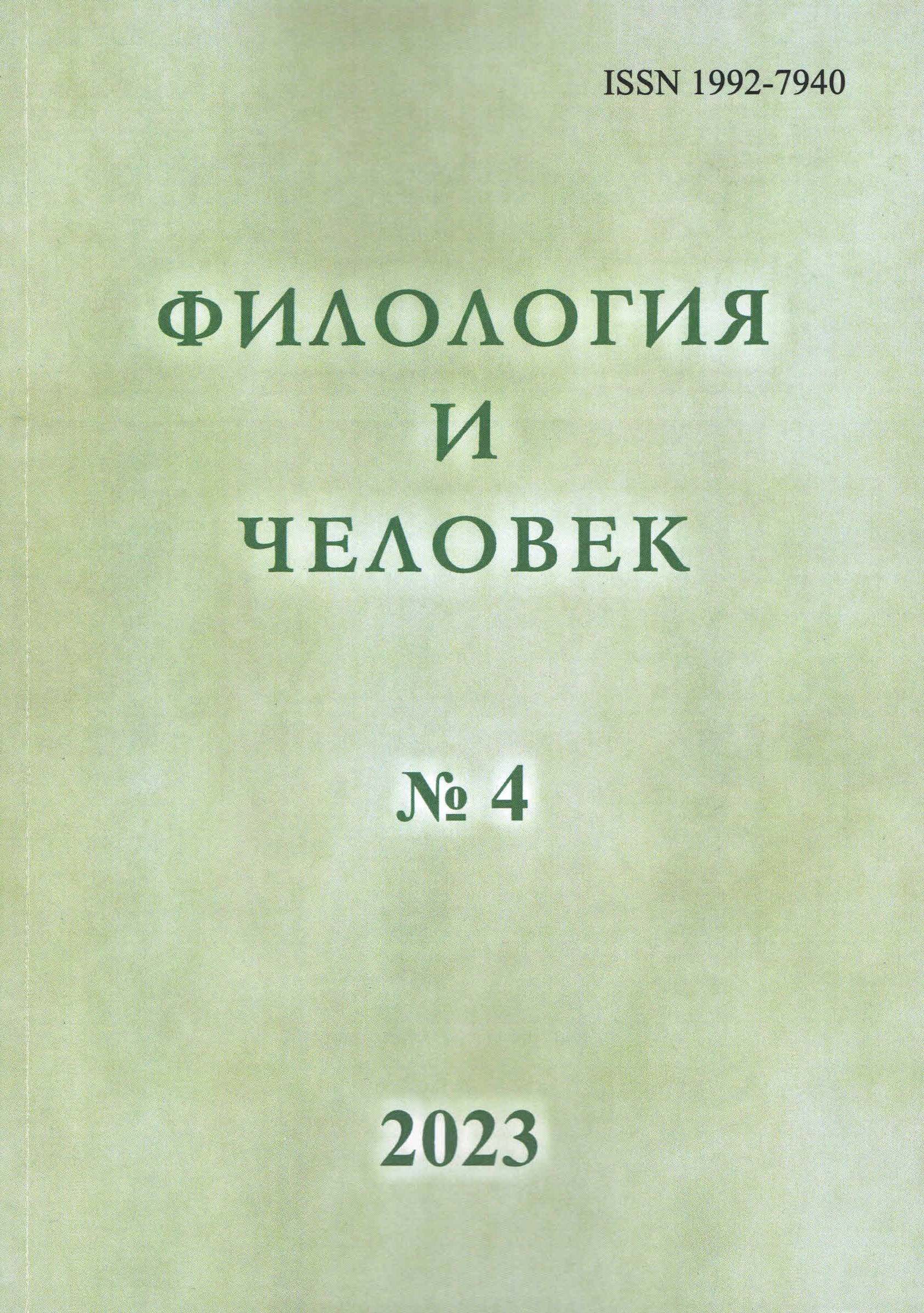Край света в центре Азии: Барнаул в романе Сергея Залыгина «После бури»
Abstract
The city of Barnaul and the Ob River, on which it stands, appear in S. Zalygin’s last novel “After the Storm” (1982-1985) under two names at once: actually as “Barnaul” and “Ob”, but mainly as “Aul” and “River”. Replacing the real Barnaul with a fictional “Aul” is designed to emphasize the transition from geographical to metaphysical space. The novel takes place in an existential chronotope: the inhabitants of the city “Aul” live “on the border between being and not being.” Zalygin skillfully plays up facts from the real history of Barnaul, turning them into elements of a geopoetic myth. The peculiarity of the Zalyginsky “Aul” is that it is “Europe in Asia” and “Asia in Europe”. Here the twentieth century is adjacent to the Middle Ages. However, in 1917, rich in revolutionary upheavals, the fragile balance of power was disrupted. The hope for the feasibility of the Eurasian synthesis burned down in the fire of a catastrophic fire, which was caused in Barnaul-Aul by the chief city fire chief. It is noteworthy that “the only Horror Book in the world” is being created in the “Aul”. A city located on the “border of two worlds – the known and the unknown” turns out to be the most suitable place to store it.
Downloads
Metrics
References
Библиографический список
Аросев Г. А. Избранник судьбы // Новый мир. 2013. № 12. [Электронный ресурс]. URL: https://magazines.gorky.media/novyi_mi/2013/12/izbrannik-sudby.html (дата обращения 02.09.2023).
Бердяев Н. А. Русская идея: Основные проблемы русской мысли XIX века и начала XX века. Париж, 1971.
Козина Т. Н. Эволюция пасхального архетипа. Тамбов, 2019.
Каскина Ю. У. Способность к преображению как черта русского национального характера (по рассказу М. Горького «Ледоход») // Вестник Костромского государственного университета. 2018. Т. 24. № 1.
Пискунова С., Пискунов В. Между быть и не быть. Натурфилософский роман: опыт прочтения // Новый мир. 1986. № 5.
Пропп В. Я. Морфология «волшебной» сказки. Исторические корни волшебной сказки. М., 1998.
Скубач О. А. Два лика Алтая в литературе 1950–1960-х гг. // Образ Алтая в русской литературе XIX–XX вв. Антология: в 5 т. Барнаул, 2012. Т. 4.
Топорков А. Л. Переправа // Славянская мифология. Энциклопедический словарь. М:, 1995.
Топоров В. Н. Пространство и текст // Текст: семантика и структура. М., 1983.
Хайдеггер М. Бытие и время. М., 1997.
Список источников
Блок А. А. Двенадцать // Блок А. А. Собрание сочинений: в 8 т. М.–Л., 1960. Т. 3.
Горький М. Ледоход // Горький М. Собрание сочинений: в 30 т. М., 1951. Т. 11.
Залыгин С. После бури. М., 1986.
Шварц Е. Л. Обыкновенное чудо: пьесы, сказки. М., 2011.
References
Arosev G. A. Izbrannik sud’by [The Chosen One of Fate]. Novyy mir [New World]. 2013. No 12. URL: https://magazines.gorky.media/novyi_mi/2013/12/izbrannik-sudby.html (accessed 02.09.2023).
Berdyayev N. A. Russkaya ideya: Osnovnyye problemy russkoy mysli XIX veka i nachala XX veka [Russian Idea: Main Problems of Russian Thought in the 19th Century and the Beginning of the 20th Century]. Paris, 1971.
Kozina T. N. Evolyutsiya paskhal’nogo arkhetipa [The evolution of the Easter archetype]. Tambov, 2019.
Kaskina YU. U. Sposobnost’ k preobrazheniyu kak cherta russkogo natsional’nogo kharaktera (po rasskazu M. Gor’kogo «Ledokhod») [The ability to transform as a feature of the Russian national character (according to the story of M. Gorky “Ice drift”)]. Vestnik Kostromskogo gosudarstvennogo universiteta [Bulletin of the Kostroma State University]. 2018. Vol. 24. No 1.
Piskunova S., Piskunov V. Mezhdu byt’ i ne byt’. Naturfilosofskiy roman: opyt prochteniya [Between being and not being. Naturphilosophical novel: reading experience]. Novyy mir [New World]. 1986. No 5.
Propp V. YA. Morfologiya «volshebnoy» skazki. Istoricheskiye korni volshebnoy skazki [Morphology of the “magic” fairy tale. The historical roots of fairy tales]. Moscow, 1998.
Skubach O. A. Dva lika Altaya v literature 1950–1960-kh gg. [Two faces of Altai in the literature of the 1950s–1960s]. In: Obraz Altaya v russkoy literature XIX–XX vv. Antologiya: v 5 t. T. 4 [The image of Altai in Russian literature of the 19th–20th centuries. Anthology: in 5 vols. Vol. 4]. Barnaul, 2012.
Toporkov A. L. Pereprava [Crossing]. In: Slavyanskaya mifologiya. Entsiklopedicheskiy slovar’ [Slavic mythology. Encyclopedic Dictionary]. Moscow, 1995.
Toporov V. N. Prostranstvo i tekst [Space and text]. In: Tekst: semantika i struktura [Text: semantics and structure]. Moscow, 1983.
Heidegger M. Bytiye i vremya [Being and time]. Moscow, 1997.
List of sourses
Blok A. A. Dvenadtsat’ [Twelve]. In: Blok A. A. Sobraniye sochineniy: v 8 t. T. 3 [Collected works: in 8 vols. Vol. 3]. Moscow.–Leningrad, 1960.
Gor’kiy M. Ledokhod [Ice drift]. In: Gor’kiy M. Sobraniye sochineniy: v 30 t. T. 11 [Collected works: in 30 vols. Vol. 11]. Moscow, 1951.
Zalygin S. Posle buri [After the storm]. Moscow, 1986.
Shvarts Ye. L. Obyknovennoye chudo: p’yesy, skazki [Ordinary miracle: plays, fairy tales]. Moscow, 2011.
Редакционная коллегия научного журнала «Филология и человек» придерживается принятых международным сообществом принципов публикационной этики, отраженных, в частности, в рекомендациях Комитета по этике научных публикаций (Committee on Publication Ethics (COPE), Кодекс этики научных публикаций), а также учитываeт ценный опыт авторитетных международных журналов и издательств.
Во избежание недобросовестной практики в публикационной деятельности (плагиат, изложение недостоверных сведений и др.), в целях обеспечения высокого качества научных публикаций, признания общественностью полученных автором научных результатов каждый член редакционной коллегии, автор, рецензент, издатель, а также учреждения, участвующие в издательском процессе, обязаны соблюдать этические стандарты, нормы и правила и принимать все разумные меры для предотвращения их нарушений. Соблюдение правил этики научных публикаций всеми участниками этого процесса способствует обеспечению прав авторов на интеллектуальную собственность, повышению качества издания и исключению возможности неправомерного использования авторских материалов в интересах отдельных лиц.





